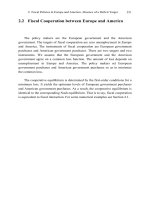Lecture 9 monetary and fiscal policy
Bạn đang xem bản rút gọn của tài liệu. Xem và tải ngay bản đầy đủ của tài liệu tại đây (491 KB, 25 trang )
Macroeconomics
lecture 9
Monetary
and
Fiscal Policy
Chapter 34
Lecture Objectives
1.
2.
3.
4.
5.
Theory of liquidity preference
Monetary policy
Fiscal policy
Multiplier effect
Crowding-out effect
•
•
Synergy of the monetary and fiscal policy
Case study
Aggregate Demand
M Value
Price
Level
P1
P2
Aggregate
demand
0
Y1
Y2
Quantity of
Output
The Money Market and Aggregate Demand
(a) The Money Market
Interest Rate
(b) Commodity & service Market
Price
Money supply
Level
2. …increases the
1. An increase in the price
demand for money…
level…
P2
r2
Money demand at
price level P2, MD2
Aggregate demand
P1
r1
Money demand at price level P1,
MD1
0
Quantity fixed by the CB
Quantity of
0
Y2
Quantity
of Output
Money
3. …which increases the equilibrium rate…
Y1
4. …which in turn reduces the quantity of
goods and services demanded.
The Theory of Liquidity Preference
◦The interest rate adjusts to balance the supply and demand for money.
Equilibrium in the Money Market
Interest
Rate
Money
supply
r1
Equilibrium interest
rate
r2
Money
demand
0
M
d
1
Quantity fixed
by the CB
M
d
2
Quantity of
Money
Monetary Policy
Central bank Change Money Supply Or Target Interest rate through:
◦Open-market operations
◦Changing the reserve requirements
◦Changing the discount rate
change in AD (consumption and investment)
change in GDP
Regulated Money Supply
(a) The Money Market
Interest Rate
Money supply,
MS1
(b) The Aggregate-Demand Curve
MS2
3. …which increases the
Price Level
quantity of goods and
services demanded at a
1. When the CB
given price level.
increases the
money supply…
P
r1
r2
AD2
Aggregate demand, AD1
0
Quantity
2. …the equilibrium interest
rate falls…
of Money
0
Y1
Y2
Quantity
of Output
How Monetary Policy Influences Aggregate Demand
◦Three reason for the downward slope of the aggregate-demand
curve:
◦The wealth effect
◦The interest-rate effect
◦The exchange-rate effect
◦The most important reason: interest-rate effect.
Strengths of Monetary Policy
◦Powerful to pursue contractionary policies
◦Swift and flexible action
◦Political acceptability
Weaknesses of Monetary Policy
◦Difficult to predict time-lag between action and outcome
◦Weak when trying to stimulate economic activity.
The Fiscal Policy
Income tax
Soc. Security
Business tax
Health
Sales Tax
Education
Excise duty
Defence
Non-tax rev.
Other
Public serv’s
Public debt
$
$
interest
Other
Revenue
Outlays
BUDGET
Fiscal policy - Measures
◦Government spendings, led to effects:
◦The multiplier effect
◦The crowding-out effect
◦Taxation
Multiplier Effect
Price
2. …but the multiplier effect can amplify the shift in aggregate
Level
demand.
$20 billion
AD3
1. An increase in government purchases of
$20 billion initially increases aggregate
demand by $20 billion…
0
AD2
Aggregate demand, AD1
Quantity
of Output
Multiplier Effect
◦The formula for the multiplier is:
Multiplier = 1/(1 - MPC)
◦MPC: marginal propensity to consume - fraction of extra income that a household
consumes rather than saves.
The Crowding-Out Effect
◦Crowding-out effect: reduction in demand that results when a
fiscal expansion raises the interest rate
The Crowding-Out Effect
(a) The Money Market
(b) The Shift in Aggregate Demand
4. …which in turn partly
Interest Rate
offsets the initial increase in
Price
aggregate demand.
Level
Money
supply
2. …the increase in
spending increases money
r2
demand…
$20 billion
AD2
r1
MD2
AD3
Aggregate demand, AD1
Money demand, MD1
0
Quantity fixed by the
Fed
3. …which increases the equilibrium interest rate…
Quantity of
0
Quantity of Output
Money
1. When an increase in government purchases increases aggregate
demand…
Changes in Taxes
The extent of effects on aggregate demand subject to:
Multiplier effect
Crowding-out effect.
Households’ perceptions
Strengths of Fiscal Policy
◦Open to public oversight transparency
◦More effective in a recession in stimulating AD than monetary
policy
◦Easy to target specific groups in the community with
assistance
Weaknesses of Fiscal Policy
◦Uncertainty of its outcomes
◦Timing/ Implementation lags
◦Political sensitivity
◦“Crowding-out” effect of budget deficit
CASE STUDY
VN stabilisation policy in 2019?
Background: at closure of 2018
•
•
•
Real GDP: 659 billion (base year: 2011)
Estimated growth rate: 7.1%
Annual inflation rate: 5.25%
GOV issued circular 01 to stabilise the economy. Which measures does
circular 01 entail?
VN stabilisation policy in 2019
◦Background: at closure of 2018
Real GDP: 659 billion (base year: 2011)
Estimated growth rate: 7.02%
Annual inflation rate: 5.25%
GOV issued circular 01
To increse the investment and GDP more?
Or to reduce the inflation rate?
Which measures should circular 01 entail?
Hints: combined monetary and fiscal policy:
Discout rate?
Minimal capital requirement at banks?
State invested infrastructure projects?
Salary scheme at public sector?
•
•
•
•
Lecture Review
◦Theory of liquidity preference
◦Monetary policy
◦Fiscal policy
◦Synergy of monetary and fiscal policy
◦Case study









